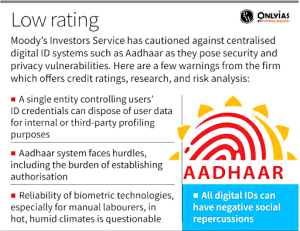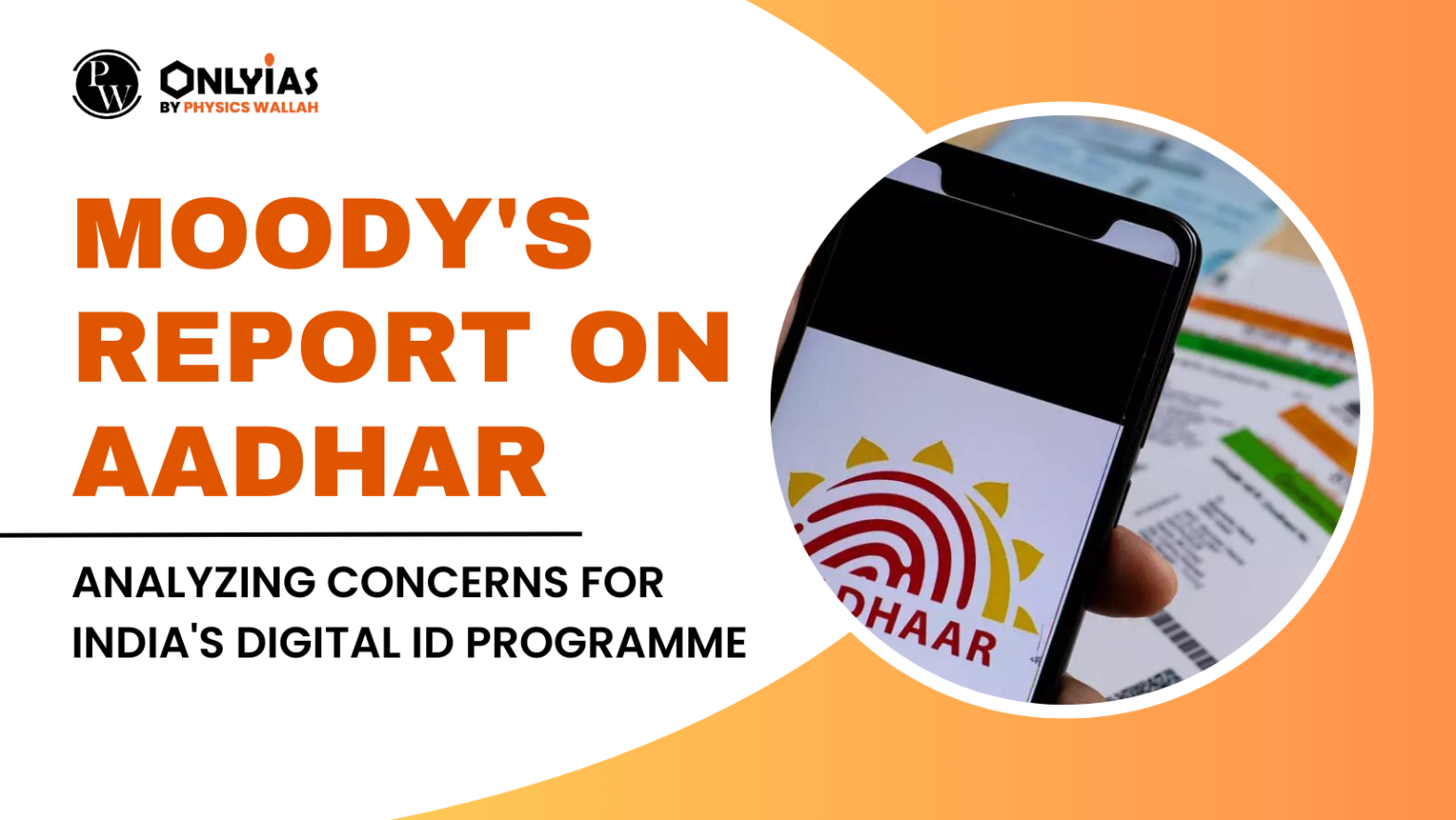Context:
- This article is based on an Editorial “Identity pangs: On Aadhar and concerns” which was published in the Hindu. A recent report by Moody’s organization titled “Decentralized Finance and Digital Assets” has raised concerns about India’s ambitious digital identification (ID) programme for residents, Aadhaar.
What is Aadhar?
-
- Wider Acceptance: Aadhar is the world’s largest digital ID programme with biometric and demographic details of over a billion residents.
- Mandatory Document: It is a 12-digit number becoming mandatory for almost all welfare benefits to weaker sections as well as activities such as opening bank or provident fund accounts, securing telephone connections and remitting taxes.
- Significance: It enables direct transfer of benefits to millions in welfare schemes and eliminating ghosts and middlemen.
- It made a relevant impact by pushing to switch all payments under the Mahatma Gandhi National Rural Employment Guarantee Act (MGNREGA) to an Aadhar-based payment system.

- Challenge: Despite its benefits, it has excluded some people from basic services due to lack of enrollment or authentication difficulties, particularly among manual laborers and senior citizens struggling to confirm their fingerprints and retina scans.
What are the concerns raised by Moody over India’s Aadhar Programme?
- Security & Privacy Concerns: The agency has signaled concerns over security and privacy risks when Aadhar serves as the single entity controlling all identifying credentials.
- Biometric Concern: The system often results in service denials, and the reliability of biometric technologies, especially for manual laborers in hot, and humid climates.
- Eye Opening Audit by Comptroller and Auditor General of India (CAG): An audit of the Unique Identification Authority of India (UIDAI) by the CAG released last year, identified privacy concerns and data security, along with flaws in enrolment processes leading to duplication and faulty biometrics.
Other Adhar Implementation Related Concerns
- Excessive Imposition: In 2018, the Supreme Court of India ruled that Aadhar authentication can be made mandatory only for benefits paid from the Consolidated Fund of India (CFI) and that alternative means of identity verification must always be provided when Aadhaar fails.
- However childrens were exempt but aadhaar continues to be routinely demanded from children for basic rights such as anganwadi services/ school enrolment, etc.
- Arbitrary exclusions: Central and state governments have made routine use of the “ultimatum method” to implement the linkage of welfare schemes with Aadhar card.
- Under this method, if the recipients fail to comply with the linkage instructions recipients may face benefit withdrawals from their job card, ration card, bank account, etc .
- Concerns over the misuse of Aadhar data: Many private entities in India are insist on an Aadhaar card, and users often share the details.
- However, there’s no clarity on how they keep these data private and secure.
Also read: AePS Transaction Model
What are the way forward suggested by Moody?
- Decentralization of Aadhar: Moody’s report suggested decentralized ID systems that give users more control over their data.
- Need for Honest Review: The government must seek an honest review of, and course correction in the Aadhaar programme, before expanding its linkages further, be it for electoral rolls, private entities or MGNREGA payments.
Conclusion
Aadhar has undoubtedly brought significant benefits in streamlining welfare schemes, Moody’s report reminds us of the critical need to address security, privacy, and inclusivity concerns. It’s essential for the government to take an honest and proactive approach to ensure the programme’s continued success and trust among citizens.
| Attempt the PY Prelims Question:
Q. Consider the following statements: (2018)
- Aadhar card can be used as a proof of citizenship or domicile.
- Once issued, Aadhar number cannot be deactivated or omitted by the Issuing Authority.
Which of the statements given above is/are correct?
(a) 1 only
(b) 2 only
(c) Both 1 and 2
(d) Neither 1 nor 2
Ans: (d)
Attempt the Mains Question: “Reforming the government delivery system through the Direct Benefit Transfer Scheme is a progressive step, but it has its limitations too”. Comment. (GS Paper 2; UPSC Mains 2022). |
![]() 28 Sep 2023
28 Sep 2023

